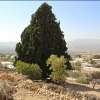Considering the sanctity of cypress for Zoroastrians and existence of an old cypress tree in this place, a building was built around the tree in order to attract visitors during the pilgrimage. The cypress tree can be clearly seen from the outside and far away.
Age of Shrine of Sarv-e Hosseini
The shrine includes a beautiful unpretentious thatch facade, a wooden door, and a badgir ( wind tower ) on the roof and archivolt ceilings which indicate the historic age of the building.
Regarding its architectural style, Shrine of Sarv-e Hossieni is related to the late Islamic period (early Qajar period). Considering the location of this shrine in Hosseini Village and next to Hosseini cypress (Sarv-e Hossieni), this place is also known as “ Pay-e Sarv-e Hosseini ” which means it is next to Sarv-e Hosseini .
Architecture of Pay-e Sarv-e Hosseini
When we arrive at the shrine , we will get into a vestibule, on the right side of which there is a staircase to the roof and on its left side, there is a wooden door to the stables. A gentle-sloped corridor and a staircase lead the visitors to the yard. The corridor divides the building into two parts.
Just in middle of the courtyard, there is a garden in which Hosseini Cypress tree catches eyes with a certain specialty. The circumference of the tree is 3 meters and its height is approximately 10 meters. There are pieces of cloth tied to the branches of the cypress which reveal its sacredness and people's pray seeking. In the other corner of the courtyard, there is another garden with pomegranate trees.
In the eastern part of the corridor, there is a three-door room (sedari) with blocked windows. There is another corridor drawn from the entrance of the room to the kitchen and in the corner of the kitchen and in an indentation, a window is located from which a Ab Anbar (water reservoir) full of water can be seen. The end of the badgir (wind tower) is drawn up to this part and used to function as an air conditioning for the water reservoir tank.
In the western part of the entrance hall, there is another room inside which another room can be seen. There had probably been a way from this room to the entrance vestibule that is blocked now.
In the northeast corner of the building, next to the yard, there is a small oven for making fire, turning on the candle, and burning up the aloes-wood is built. If you look up at the ceiling, you can see a hole as air conditioning. On the wall of the courtyard, two small holes are included to place the half-burning vowed candles in themselves. The roof is made of thatch and a badgir is located above it.
Ab Anbar of the Shrine
At the southern front of the shrine wall, the water reservoir facade and stairs are visible. Pass through the ten stairs and shift 90 degrees to the main stairs of the Ab Anbar which leads you to the faucet. It's interesting to know that this Ab Anbar has two separate entrances: one for men and one for women. Another entrance of the Ab Anbar is behind this mentioned direction located on the west front of the building. The bath of the Ab Anbar is located below the building of Shrine of Sarv-e Hosseini and its water is provided from Hosseini well.
Shrine of Sarv-e Hosseini was registered in Iran National Monuments on January 26, 2011 with registration No. 29975.
Source: Archives of Library Documents of Yazd Cultural Heritage, Handicrafts and Tourism Organization .
For more information about Shrine of Sarv-e Hosseini, please contact Raadina Support.
Online Support













